I have a x,y distribution of points for which I obtain the KDE through scipy.stats.gaussian_kde. This is my code and how the output looks (the x,y data can be obtained from here):
import numpy as np
from scipy import stats
# Obtain data from file.
data = np.loadtxt('data.dat', unpack=True)
m1, m2 = data[0], data[1]
xmin, xmax = min(m1), max(m1)
ymin, ymax = min(m2), max(m2)
# Perform a kernel density estimate (KDE) on the data
x, y = np.mgrid[xmin:xmax:100j, ymin:ymax:100j]
positions = np.vstack([x.ravel(), y.ravel()])
values = np.vstack([m1, m2])
kernel = stats.gaussian_kde(values)
f = np.reshape(kernel(positions).T, x.shape)
# Define the number that will determine the integration limits
x1, y1 = 2.5, 1.5
# Perform integration?
# Plot the results:
import matplotlib.pyplot as plt
# Set limits
plt.xlim(xmin,xmax)
plt.ylim(ymin,ymax)
# KDE density plot
plt.imshow(np.rot90(f), cmap=plt.cm.gist_earth_r, extent=[xmin, xmax, ymin, ymax])
# Draw contour lines
cset = plt.contour(x,y,f)
plt.clabel(cset, inline=1, fontsize=10)
plt.colorbar()
# Plot point
plt.scatter(x1, y1, c='r', s=35)
plt.show()

The red point with coordinates (x1, y1) has (like every point in the 2D plot) an associated value given by f (the kernel or KDE) between 0 and 0.42. Let's say that f(x1, y1) = 0.08.
I need to integrate f with integration limits in x and y given by those regions where f evaluates to less than f(x1, y1), ie: f(x, y)<0.08.
For what I've seen python can perform integration of functions and one dimensional arrays through numerical integration, but I haven't seen anything that would let me perform a numerical integration on a 2D array (the f kernel) Furthermore, I'm not sure how I would even recognize the regions given by that particular condition (ie: f(x, y)less than a given value)
Can this be done at all?